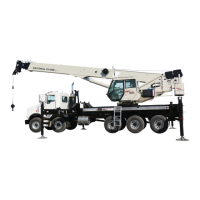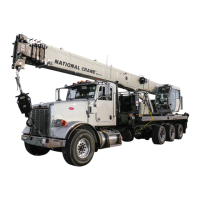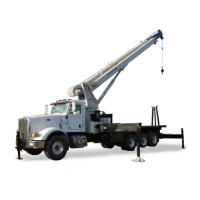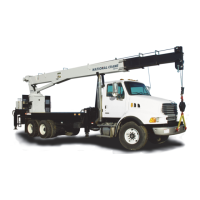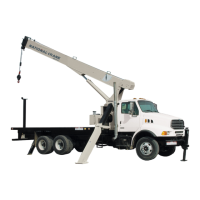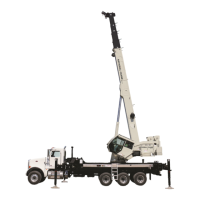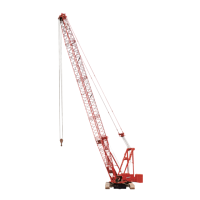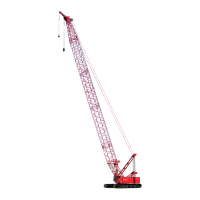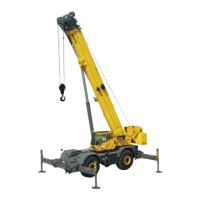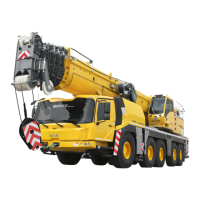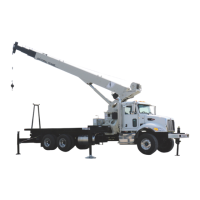
Do you have a question about the Manitowoc National Crane NBT30H-2 and is the answer not in the manual?
| Brand | Manitowoc |
|---|---|
| Model | National Crane NBT30H-2 |
| Category | Construction Equipment |
| Language | English |
Provides general information about the operator manual.
Details on additional manuals and resources for the crane.
Instructions for reporting accidents, malfunctions, and equipment damage.
Describes the terminology used for crane parts throughout the manual.
Explains the use of safety alert symbols and signal words to denote hazards.
Emphasizes operator responsibility and basic safety principles for equipment operation.
Procedures to follow after an accident or equipment damage.
Requirements for operators regarding manual and safety video understanding.
Explains the meaning and use of the safety alert symbol.
Defines DANGER, WARNING, and CAUTION signal words for hazard severity.
Defines a qualified person and requirements for crane operators.
Describes accessories that provide information or control crane functions.
Explains the function of RCL systems in monitoring and preventing overloads.
Discusses the importance and testing of the anti-two-block system.
Explains the hazard of two-blocking and how to prevent it.
Details the function of a working area limiter as an operational aid.
Emphasizes ensuring equipment stability and structural integrity before lifting.
Explains the purpose of load charts and their importance for safe operation.
Discusses the importance of inspecting the work site for safe operation.
Provides basic principles for operating in windy conditions and the effect of wind on loads.
Details how to determine permissible wind speeds and capacity reduction factors.
Outlines general guidelines for performing a lift safely and effectively.
Discusses the importance of proper counterweight installation for lift stability.
Explains the occurrence of outrigger lift-off and its implications for stability.
Advises against multiple equipment lifts and outlines safety precautions if performed.
Provides specific precautions for performing tilt-up panel lifts with two hoist lines.
Outlines approved operating requirements for pile driving and extracting.
Warns about the dangers of operating near electrical power lines and sources.
Details precautions for setting up and operating near electrical power sources.
Discusses the limitations of devices designed to protect against electrical hazards.
Addresses operation during electrical thunderstorms and near transmitter towers.
Explains the procedure for grounding the equipment to prevent static electricity.
Covers proper disposal of hazardous waste and environmental regulations.
Emphasizes the importance of regular maintenance for crane safety and longevity.
Provides guidelines and precautions for lubricating the equipment.
Details inspection and maintenance for tires, including safety warnings.
Discusses inspection, care, and replacement of hoist ropes.
Provides detailed information on wire rope inspection, removal criteria, and handling.
Covers fueling, fire extinguisher location, and engine checks.
Outlines procedures and checks for safely transporting the equipment.
Provides guidelines for safe operation while traveling with the equipment.
Covers safe operating practices for personnel and equipment.
Details essential steps for preparing the equipment and work area before operation.
Outlines operator responsibilities and safe working procedures during operation.
Provides essential guidelines and precautions for safe lifting operations.
Explains the use of standardized hand signals for crane operation.
Details safety procedures for erecting, stowing, and using the jib.
Provides instructions for safely parking and securing the equipment when unattended.
Lists the steps for properly shutting down the equipment.
Offers recommendations and precautions for operating the crane in cold weather.
Outlines inspections required after an overload condition is detected by the RCL system.
Provides a guide for inspecting the boom sections for damage and wear.
Details inspection points for the superstructure and its components.
Outlines inspection points for the carrier and its associated systems.
Introduces the section covering crane controls and operating procedures.
Describes the controls located in the truck cab used in conjunction with crane operations.
Explains the requirement for the truck ignition switch to be ON for crane operation.
Details the function and proper usage of the Power Take Off (PTO) system.
Identifies the location and function of the crane's control stations and their components.
Explains the function and operation of the emergency stop switch.
Describes the indicator light and alarm for two-block or extension overload conditions.
Details the operation of the handheld outrigger control box for outrigger functions.
Explains the use of level indicators to ensure the crane is properly leveled.
Describes the main operator control console and its functions.
Explains the operation of the main power switch for the truck and crane.
Details how to operate the lever for extending and retracting the boom.
Explains the operation of the lever for raising and lowering loads.
Describes the operation of the lever for rotating the crane superstructure.
Details how to operate the lever for raising and lowering the boom.
Explains the function of the foot throttle for controlling engine speed.
Guides on how to use load charts to determine lifting capacities.
Describes the RCL display and its role in providing operational information.
Explains the function of the RCL override key switch for disabling safety features.
Introduces the section detailing how to operate the crane.
Lists essential pre-operation checks for safe equipment use.
Provides recommendations for operating the crane in arctic conditions.
Details procedures for warming up crane components before operation.
Discusses operating limits and warm-up procedures for the hydraulic oil system.
Explains the procedure for checking the functionality of the anti-two block system.
Outlines the steps to verify the proper operation of the Rated Capacity Limiter.
Provides general rules and precautions for hoist system operation.
Advises on selecting a suitable and safe work site for crane operations.
Lists essential steps to take before initiating a lift operation.
Explains the design and purpose of load charts for safe operation.
Guides on how to interpret and use load charts for determining lifting parameters.
Outlines general guidelines for performing a lift safely after proper setup.
Details the components and function of the Manitowoc RCL system.
Explains the display and warnings associated with the RCL operating mode.
Describes how to set slew angle limits within the RCL system.
Guides on configuring the RCL system for crane operation.
Explains how the Outrigger Monitoring System displays outrigger positions.
Details how to use the TARE function to calculate net load weight.
Explains the RCL operating mode screen and its key functions.
Covers setting operational limits such as slew angle and radius limits in the RCL.
Discusses considerations for leaving the crane unattended and safe configurations.
Details the steps required to activate and use the crane remote control.
Introduces the section on how to perform various setup tasks for the crane.
Provides comprehensive instructions for setting up the outriggers for stable operation.
Explains the critical importance of leveling the crane within 1% of grade.
Details the procedure for checking and adjusting the bubble level indicator.
Advises on choosing a stable and level surface for outrigger placement.
Guides on the systematic process of extending and setting all outriggers.
Describes the OMS function in identifying outrigger beam positions for RCL setup.
Provides critical safety precautions and guidelines for using crane extensions.
Details the procedures for deploying the side folding swing around extension.
Step-by-step instructions for safely deploying the swing around extension.
Provides instructions for safely stowing the swing around extension.
Outlines the steps required to remove the extension from the boom.
Covers routine maintenance required for the extension.
Details the procedure for installing the anti-two block weight.
Explains how multi-part line reeving enables lifting heavier loads.
Provides specific requirements for lifting a 30-ton load.
Step-by-step guide for installing the hoist cable.
Explains how to properly install wedge sockets for secure cable attachment.
Details the procedure for attaching a terminator wedge socket.
Provides instructions for correctly installing a wedge socket.
Illustrates ANSI approved methods for treating wire rope dead-ends.
Introduces the section on lubrication procedures and charts for crane maintenance.
Covers proper disposal of waste and environmental regulations related to lubricants.
Discusses lubricant selection based on availability and operating conditions.
Provides recommendations for using fluids in sub-zero temperature conditions.
Details the type and application of chassis grease for lubrication.
Explains the importance of selecting proper hydraulic oil for system performance and life.
Specifies the standard hydraulic oil and its acceptable operating temperature range.
Recommends petroleum-based fluids for colder environments and specifies limits.
Outlines procedures for inspecting hydraulic oil condition and filter status.
Emphasizes establishing a regular lubrication schedule for component longevity.
Identifies various points on the crane requiring lubrication and their recommended intervals.
Explains how to check, drain, and add oil to the hoist brake system.
Guides on checking, draining, and filling the hoist gearbox with oil.
Describes how to check and maintain the hydraulic oil reservoir level.
Explains the importance and methods of lubricating wire rope for longevity and protection.
Introduces Carwell® Rust Inhibitor and its protective properties.
Discusses common causes of crane corrosion and preventive measures.
Provides guidelines for cleaning the crane to help protect against corrosion.
Recommends inspections after cleaning and procedures for repairing paint damage.
Details how and when to apply the rust inhibitor treatment.
Outlines regularly scheduled inspection and maintenance intervals for peak condition.
Lists inspection intervals conducted to ensure safe and proper operation.
Details essential checks to be performed by the operator at the start of each day.
Lists items to be checked weekly by the operator.
Lists items to be checked monthly by maintenance personnel.
Outlines inspections to be performed at least every three months, including records.
Describes a thorough boom inspection requiring disassembly if not done recently.
Emphasizes checking unit stability throughout the working area annually or after changes.
Covers frequent and periodic inspections and maintenance of the hoist cable.
Explains how abnormal loads can shorten wire rope life expectancy.
Provides safety precautions and recommendations for performing inspections.
Outlines daily, monthly, and quarterly inspection requirements for hoist cable.
Discusses factors and reasons for replacing wire rope.
Provides guidelines for handling wire rope to prevent damage and ensure safety.
Covers safety information before starting adjustments and repairs.
States that replacement cables must be obtained from Manitowoc Crane Care.
Details service and maintenance for extension jacks, including oil types.
Recommends adding lubrication oil to pivoting sections quarterly.
Advises checking rams for rust and corrosion every three months.
Covers requirements and maintenance for the hydraulic system, including the oil cooler.
Lists the operational speeds for various crane functions like rotation and boom movement.
Details the operating speeds for outrigger beam and jack extension/retraction.
